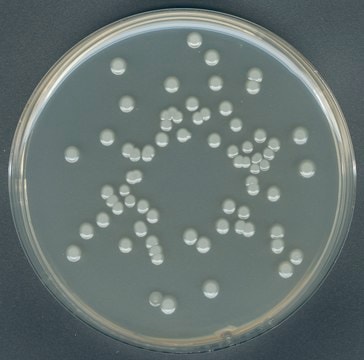1.03867
GranuCult® plus Deoxycholate Hydrogen sulfide Lactose Agar
acc. SAKAZAKI
About This Item
Recommended Products
Quality Level
form
powder
technique(s)
microbiological culture: suitable
application(s)
food and beverages
pharmaceutical
suitability
nonselective for enterobacteriaceae
General description
Colonies of Proteus, Morganella, Rettgerella and Providencia are, however, surrounded by dark brown zones, which occur, because these species act on the phenylalanine of the peptone to produce phenylpyruvate, which forms an iron complex with iron(III) ions.
The sucrose content of the medium permits differentiation of weakly lactose-positive or lactose-negative, sucrose-positive species from sucrose- and lactose-negative Enterobacteriaceae.
The deoxycholate largely suppresses the growth of Gram-positive bacteria and prevents the swarming of Proteus species. This medium provides a rich nutrient base and contains a relatively low concentration of the inhibitor deoxycholate. These properties permit growth of even fastidious strains of Salmonella and Shigella. The colonies formed are considerably larger than those found on other selective culture media. Proteus, Morganella, Rettgerella and Providencia can be differentiated from Salmonella.
Neutral Red is a pH indicator and agar is the solidifying agent. .
Application
Other Notes
Footnote
The designations basic, plus, or prime are added to indicate the quality control level, from basic quality control to standard QC plus to prime for full regulatory compliance.
Legal Information
Storage Class Code
11 - Combustible Solids
WGK
WGK 3
Regulatory Listings
Regulatory Listings are mainly provided for chemical products. Only limited information can be provided here for non-chemical products. No entry means none of the components are listed. It is the user’s obligation to ensure the safe and legal use of the product.
ISHL Indicated Name
Substances Subject to be Indicated Names
ISHL Notified Names
Substances Subject to be Notified Names
Certificates of Analysis (COA)
Search for Certificates of Analysis (COA) by entering the products Lot/Batch Number. Lot and Batch Numbers can be found on a product’s label following the words ‘Lot’ or ‘Batch’.
Already Own This Product?
Find documentation for the products that you have recently purchased in the Document Library.
Our team of scientists has experience in all areas of research including Life Science, Material Science, Chemical Synthesis, Chromatography, Analytical and many others.
Contact Technical Service